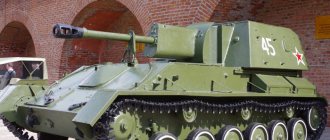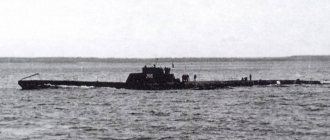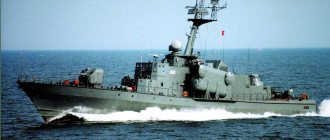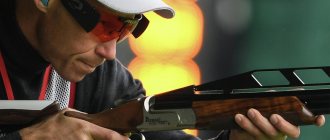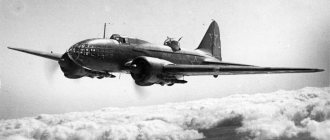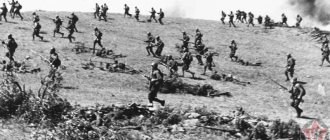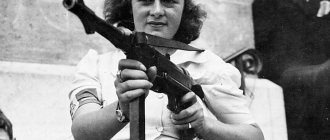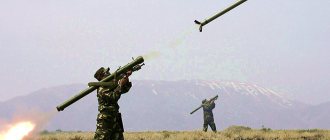(link)
Rescue of hostages by special forces from the film “Slip” (2013).
What should you do if you want to insert a quartet of fighter, cleric, mage and thief into a work, but the setting of the work is about world wars, cyberpunk and star wars? It's simple - call them the Assault Group
.
What is an assault group? This is a small (half a dozen) group of fighters, trained and equipped for sudden actions against an enemy outnumbered. And for these actions to be successful, the group makes the most of terrain conditions that help reduce the enemy’s advantage to nothing - cramped trenches, buildings and very rough terrain. This is not always special forces; the role of stormtroopers can be played by a gang of marginalized people, partisans, and often even yesterday’s conscripts.
History[edit]
There have always been small groups of selected fighters to perform special tasks. Actions on the walls of fortifications and decks of ships, in cramped glanders and trenches required the highest personal training from fighters, but before the advent of truly massive armies, experienced grunts were usually collected ad hoc from around the world in any unit, and weapons and tactics were very similar to those what we see in fantasy RPGs. Everything changed radically during the First World War, when the training and equipment of stormtroopers was put on a stream and on a centralized basis.
The trench, occupied by a sufficient number of soldiers with rifles and machine guns and fenced off from the enemy by mines and barbed wire, turned out to be an almost insurmountable obstacle to the classical (at that time) attack by a crowd of infantry from the front[1]. But if at least a dozen trained soldiers manage to get into it (for example, using the cover of night, or artillery shelling, or a smoke screen), then from the entire unit only a couple of people at a time will be able to fight with these infantrymen, the rest simply will not lines of fire due to the bends of the trench and the backs of his comrades. And if the fighters who penetrated the trenches are more prepared than the defenders and, in addition, have good equipment[2], the trench will be cleared with little (for the attacker) bloodshed.
In addition, the period of the "Run to the Sea" was characterized by a terrible decline in morale on all sides involved, culminating in the famous football match in no man's land and the Christmas Truce. To increase tension at the front, both sides of the conflict began to resort to sabotage tactics - creating groups that would break into enemy trenches and capture trophies and prisoners. It cannot be said that this gave immediate results, but in general, friendliness towards the guy on the other side of the front began to decline.
The most famous were the assault infantrymen of Germany, where the training of such groups was put on stream, and the famous Arditi of the Italians. As a rule, assault groups and units were formed by a simple selection of the most experienced and powerful fighters in linear units.
During the Second World War, fortifications became less capital (the Red Army generally used individual cells in the summer of 1941) and alternative methods of combating them appeared. But battles for cities began to occur much more often, where battles for individual buildings were in no way inferior in ferocity to battles in the mud- and water-filled trenches of Passchendaele. In addition, guerrilla warfare reached large proportions, especially in forests and jungles, where the abundance of cover made similar tactics popular. The practice of forming assault groups from line infantry fighters remained and was successfully used by the Germans, but there were also numerous engineering and sapper units, whose personnel were specially trained for subversive activities in trenches and buildings, as well as airborne paratroopers, trained in principle for everything. In the USSR, before the Great Offensive of 1944, assault engineer brigades (SHISBr) were formed, which were armed with the famous SN - the Steel Breastplate, which represented the good old cuirass [3].
In the post-war period, the demand for assault groups was provided by the terrorist threat, organized crime and local low-intensity conflicts.
New war
The Second World War and the Great Patriotic War became, as is known, “wars of engines.” In the East, the German blitzkrieg is stuck. In difficult battles, it quickly became clear that if armies lose maneuver and come face to face in a brutal urban battle, the “engines” do not help much.
Soviet attack aircraft in battle
Source: topwar.ru
In reality, back in the winter of 1941-1942, future Marshal G.K. During the counter-offensive near Moscow, Zhukov demanded “to stop the practice of criminal attacks on enemy positions head-on.” Even then, some theoretical developments and instructions for the actions of the Soviet infantry on the offensive began to emerge.
The next milestone that predetermined the birth of Soviet attack aircraft was heavy street fighting in Stalingrad. Even then, on the destroyed streets of the city on the Volga, in the battles for floors, basements, houses and factories, the specifics of assault combat began to appear. While he was on the defensive, however, this did not cancel the special type of recruitment of Soviet units.
And after the fight
Source: pikabu.ru
More grenades, automatic small arms, effective at close range, explosives, flamethrowers and heavy weapons - the German line infantry broke their teeth on all this, which was untimely and not fully able to adapt to the new realities of battle. You can read about this in the book of the German general M. von Fretter-Picot “German Infantry. Strategic mistakes of the Wehrmacht."
A tank is a stormtrooper's best friend[edit]
By the end of the Second World War, when experience had already been gained in using tanks on the battlefield, the tactics of their use crystallized by themselves, which was based on the advancement of the tank and the use of its weapons against stationary targets and against other tanks, accompanied by a cover group whose task was destroying everything that could harm the tank. In urban combat, a tank without cover became a guaranteed death for the crew, because by that time RPGs had become widespread, and then the situation only worsened. In turn, the tank helped the attack aircraft to effectively clear the enemy from any cover, thanks to the main gun with armor-piercing and high-explosive fragmentation shells, destroying any fortifications with one hit, and thus neutralized the enemy’s numerical advantage (an additional achievement if you managed to kill a truck with meat). Moreover, strictly speaking, this combat vehicle does not have to be a tank - the Red Army with great success in this role used the light self-propelled gun SU-76 - a three-inch ZIS-3 on the chassis of the T-70 light tank - popularly nicknamed “Naked-Ass Ferdinand”, [4 ] for a similar silhouette and cardboard bulletproof armor.
What was the problem?
The tactical stalemate on the fronts did not simply arise because the opposing sides dug trenches, deployed barbed wire in front of them and installed machine guns. Good artillery preparation swept away even lesser obstacles. The problem of the Western Front was that the enemy, using railways, transferred reinforcements to the attack site faster than the attackers had time to make any progress.
And everything that was captured at the cost of millions of shells and tens of thousands of corpses was soon repulsed by a counterattack of fresh forces.
This means that it was necessary to increase the effectiveness of the attack. Well, or at least reduce the consumption of people in them - so that there is something to fight with tomorrow. And the tactics of the assault troops met both of these tasks.
Tactics[edit]
The main feature of assault groups is that in order to defeat a stronger enemy, they have to use all possible advantages and impose those battle conditions that are beneficial specifically to the stormtroopers. Therefore, attack aircraft attack first, from an ambush or when the enemy is not waiting. Stormtroopers use terrain, superior personal training, or better weaponry to neutralize enemy numbers. Often assault groups impose close combat on the enemy, even hand-to-hand combat.
Another important part is timely departure. If the enemy is not planned to be destroyed with a quick and decisive blow, and reinforcements are not expected to arrive to the stormtroopers to consolidate the initial success, then it is much more useful to leave than to allow yourself to be drawn into a battle of attrition, where the enemy will simply win due to numbers. They hit us and moved away.
Eye of Ludendorff
The Germans began to actively use assault troops in 1916. Something resembling stormtroopers arose in parallel in several units at once. But Captain Rohr's battalion made history - it was there that General Ludendorff himself arrived in September 1916.
On the same topic
“Black day of the German army”: how Germany was tired of war
The general appreciated the hacking tactics demonstrated to him - so much that he saw in it a means, if not to win the war, then at least not to lose it. And he ordered the formation of one assault battalion after another. By 1918, Germany, weak relative to its opponents, was holding on to its word of honor - something had to be done urgently. Stormtroopers looked like an excellent “asymmetrical solution.”
In the spring, Ludendorff launched a “peace offensive” - this was the last chance to end the war on more or less acceptable terms. The bet was placed on attack aircraft.
At first everything went well. Intense artillery raids, carefully planned attacks on positions scouted from the air, gas attacks cutting off enemy reinforcements, rapid advance of assault troops and throwing grenades at the enemy. The defense was hacked, the front was broken through.
Stormtroopers on the attack
Weapons and equipment[edit]
Assault teams' weapons vary in both quality and quantity, depending on the setting and environment. It is logical that a partisan detachment fights with what is at hand, but special forces have access to the best weapons in the world. But both have common features:
- The focus on close combat gives rise to a love for shotguns, submachine guns, shortened versions of machine guns, grenades and melee weapons (from daggers and sapper blades, to axes, maces and officer's sabers with a shortened blade). Right down to the flamethrowers that were popular during WWII. The weapon must be mobile and provide close-range fire density. The M1897 shotguns, beloved by the Americans, proved to be so successful in the WWI trenches (thanks to the pump-action reloading system, they had a higher rate of fire than German rifles) that they received the nickname “trench broom,” and the Germans, who suffered greatly from them, repeatedly tried to get them banned in various international conventions
- However, this does not mean abandoning machine guns and sniper rifles. Someone must press down the enemy with fire and take out especially important opponents with accurate shots. However, support usually does not get involved directly in the fight, sits in the distance and takes down particularly arrogant attack aircraft directly upon request.
- Defensive weapons. The value of each individual Stormtrooper is much higher, so protection is much more important. Body armor and cuirasses, assault shields and the like. Recently, with the increase in the number and role of urban battles, there has been a return to individual units of assault sappers, who began to be dressed in natural full armor, although, for now, only anti-fragmentation armor: a person simply cannot lift full-fledged bulletproof armor that protects against modern armor-piercing cartridges. That is why exoskeletons are now being developed in full force: even a passive one, it allows you to carry much more armor.
- Special equipment. Starting from primitive mirrors on a stick and smoke grenades to thermal imagers, flash-bang grenades, sleeping gas and drones with cameras. Everything to discover and surprise the enemy before he finds and surprises you.
Attempt at solution
Without thinking yet about the development of success in the event that they still manage to break through the positions, the Germans turned their attention to the most “convex” problem lying on the surface - overcoming no-man's land and quickly capturing enemy positions.
And here everything pointed to the tactics of many separate groups operating independently of each other.
Firstly, due to their compactness and ease of control, they inevitably move faster on a battlefield riddled with craters. Secondly, they can set individual targets - for example, an enemy machine gun. Thus, strikes will be delivered more accurately, “turning off” the cornerstones of the enemy’s defense from the game.
Yes, each of the groups will inevitably be weaker than a large group of attackers in a single formation. But trench combat is largely a grenade fight. And it doesn’t make much difference how many “rifles in a line” there will be - just as there isn’t even a line itself anymore.
The main thing is to take more grenades with you and skillfully throw them. Which is safer than leaning around the next corner of a trench and trying to hit someone. Yes, and easier.
However, the matter was not limited to grenade launchers alone. Assault groups were distinguished by the specialization of team members. For example, they had their own “pocket artillery” in the form of trench mortars, which were much easier to quickly contact and adjust fire than with the “big guns” in their rear. Or light machine guns to pin the enemy to the ground. And also sappers, snipers, ammunition carriers - and so on, based on the available resources and the specific task.
Examples[edit]
Literature[edit]
- Ernst Junger, “In Steel Thunderstorms” is an autobiography of one of the founders of the subject.
- Bernard Cornwell. Series "Richard Sharp". The main character regularly has to participate in risky assaults. Including, as the commander of “Desperate Hope”, a combined detachment of volunteers for the first wave of assault on the fortifications. If the assault is successful, rewards will rain down on the survivors.
- Frederick Forsyth. "Dogs of war". The main characters form a real assault group with heavy cover from grenade launchers and mortars.
- “The fourth toast” by A. Bushkov. The main characters are FSB special forces soldiers. There is a sniper, a grenade launcher, and a machine gunner. Not everyone made it to the finals.
- "The Expansion" (and the series). The crew of the Rocinante regularly have to fight in enclosed spaces. Unfortunately, grenades are rarely remembered, although they are there. The situation here is rather that the ship is civilian, and the crew consists almost entirely of civilians, which implies the absence of weapons.
Cinema[edit]
- Star Wars is an inversion. Only the main characters remember about hiding in cover; they also remember about grenades already in Return of the Jedi. But in “Rogue One” they showed, however, not in the building (where there was an almost failed stealth mission), but in the city and the jungle.
Animated series[edit]
- The Clone Wars, unlike the films, gets everything right. With local specifics in the form of tanking Jedi. The pedal to the metal is pressed to the floor by Captain Fordo's ARC fighters from Tartakovsky's 2003 Wars.
Anime, manga, light novel[edit]
- "Black Lagoon" is played by all parties. First, a detachment of mercenaries breaks into the “Yellow Flag” with the aim of organizing a branch of the local cemetery. And then Revy and Dutch drop in on a Nazi party in the middle of the ocean.
- Gundam. In the very first series there was an almost successful attempt to storm the White Base. Typically, both sides actively use angles and grenades. Similar to the hijacking of the Gundams at the beginning of Sid.
Video games[edit]
In principle, any SF-role-playing and team-based shooters. Please add only imperishables.
- XCOM. Before the restart, it was quite possible to bring a crowd to the battlefield, but as soon as it came to clearing plates and buildings, it was necessary to use a subject. In the restart, the maximum squad size was simply reduced to 6 people. In the Long War mod, the squad can be increased to 10 (and if you tweak the parameter in the files, even more) people and the assault part of the squad becomes relevant again.
Comics[edit]
- Black Powder, Red Earth - Amber group.
Board games[edit]
- Warhammer 40,000. An ideal example of such a unit is the Kill-team of the Ordo Xenos Deathwatch. Consists of a Tactical Marine (Commander/Rifleman), Assault (Melee), Devastator (Heavy Ranged Weapon), Apothecary (Medic), Techmarine (Engineer and Walking Tank) and optionally a Librarian (Mage). Another analogue is the inquisitor's task force. An elite squad where you can find veterans of the Guard and bounty hunters, combat psykers, and repentant sorcerers. And if you look hard enough, you can get a space marine, a xenos mercenary, and even a chthonic demonhost!
- Orcs can also form assault groups! Orc style: Orc stormtroopers are painted purple and try to look like special forces, but the result is a subject. What difference does it make to orcs? WAAAAAAAAAGH!!!
- There is also a small-format spin-off Kill Team, where it is proposed to play the subject from different sides - in the original trailer, for example, the Kriegs act against the Orc commandos.
Other[edit]
- GI Joe, in all iterations, is trope-centric.
How did stormtroopers appear?
It is no secret for fans of military history that since ancient times, when major battles took place, commanders sought to divide their forces into types of troops. But often, for some special tasks, it was necessary to form separate detachments or military units. Storming any type of fortification has been the most difficult and dangerous task since ancient times. And the most experienced warriors and commanders were always selected for it.
Russian attack grenadier of the First World War
Source: pinterest.ru
After the invention of firearms and the introduction of mass armies fighting along a linear principle, the tactics of grenadier and sapper assault units began to develop rapidly.
The real “finest hour” of the assault groups was the First World War. Already from 1915-1916, when it became clear that the usual full-length infantry attacks, familiar to all of us from films, did not give results, military leaders began to look for another way out of the situation.
In conditions of imperfect armored vehicles, attack aircraft become such a “ram” for breaking through echeloned enemy positions. All parties to the conflict began to develop the tactics and theory of using such groups.
German stormtroopers in bulletproof vests
Source: pinterest.ru
Consisting of experienced fighters and commanders, better armed and equipped (and sometimes even armored) attack aircraft tore into enemy positions, making their way into the operational space for linear units. This is clearly demonstrated by the tough German offensive operations of 1918 and the Russian shock units of 1917.
